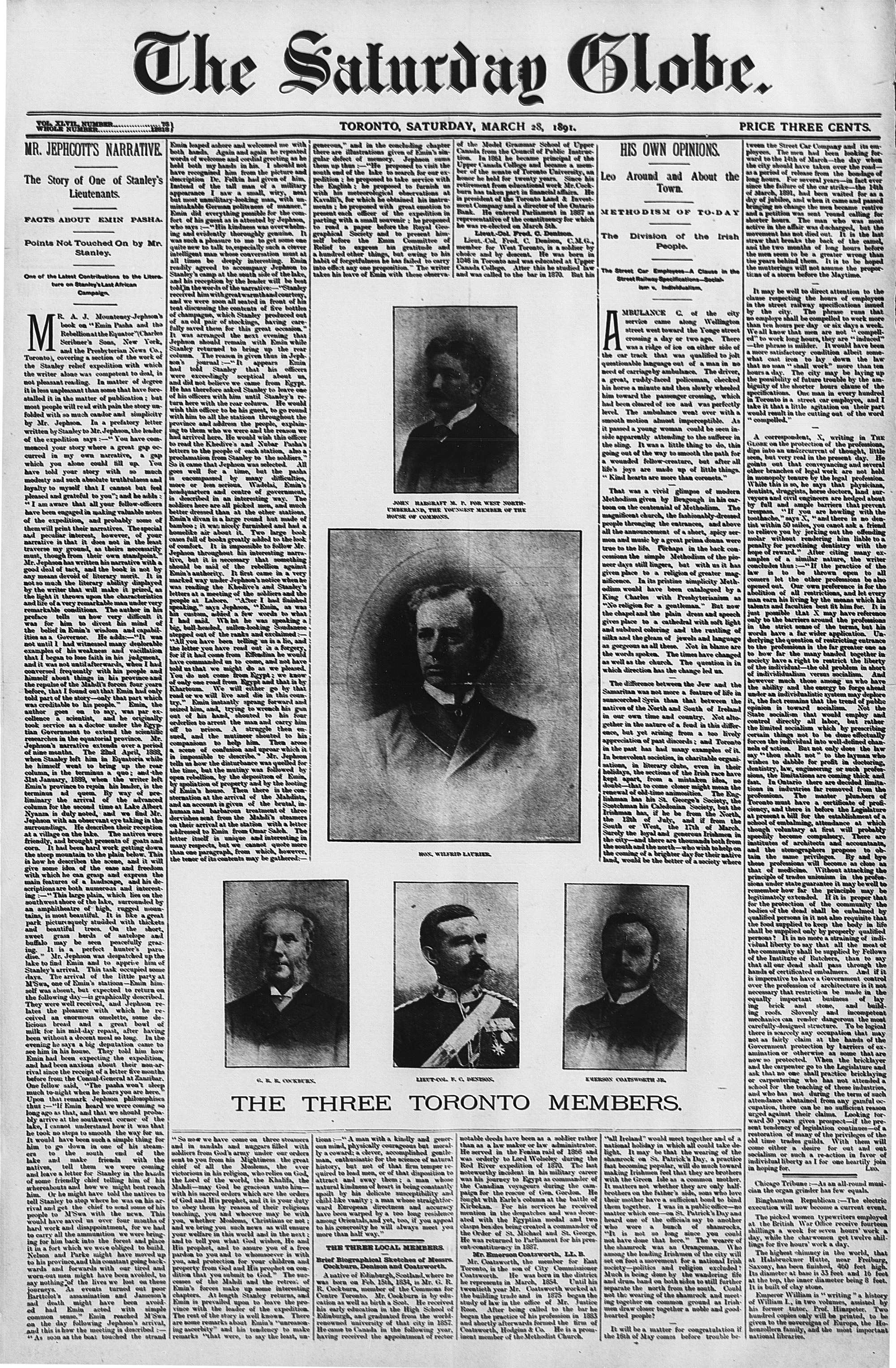Browse "Things"
-
Article
Newfoundland Bill
The people of Newfoundland rejected Confederation in 1867, choosing to remain a British colony until 1948, when a majority of voters indicated their willingness to join Canada.
"https://development.thecanadianencyclopedia.ca/images/tce_placeholder.jpg?v=e9dca980c9bdb3aa11e832e7ea94f5d9" // resources/views/front/categories/view.blade.php
https://development.thecanadianencyclopedia.ca/images/tce_placeholder.jpg?v=e9dca980c9bdb3aa11e832e7ea94f5d9
-
Macleans
Newfoundland Celebrates 500 Years
This article was originally published in Maclean’s magazine on June 23, 1997. Partner content is not updated. These days, the classrooms and corridors of Matthew Elementary School in Bonavista, Nfld., are like a shrine to John Cabot.
"https://development.thecanadianencyclopedia.ca/images/tce_placeholder.jpg?v=e9dca980c9bdb3aa11e832e7ea94f5d9" // resources/views/front/categories/view.blade.php
https://development.thecanadianencyclopedia.ca/images/tce_placeholder.jpg?v=e9dca980c9bdb3aa11e832e7ea94f5d9
-
Article
Newfoundland Dog
The Newfoundland dog is one of five Canadian dog breeds. In the past, the breed was used as a draft animal and as a companion to Canadian fishermen. Known for its ability to swim, the Newfoundland dog’s reputation as a water rescuer is unparalleled. The dog is a symbol of the province of Newfoundland and Labrador and the subject of many stories and legends based on the breed’s bravery and loyalty. ( See also Dogs in Canada.)
"https://d2ttikhf7xbzbs.cloudfront.net/media/new_article_images/NewfoundlandDog/NewfoundlandDogPortrait.jpg" // resources/views/front/categories/view.blade.php
https://d2ttikhf7xbzbs.cloudfront.net/media/new_article_images/NewfoundlandDog/NewfoundlandDogPortrait.jpg
-
Editorial
Editorial: How the “Canadianized” Community of Newfoundland Joined Canada
The following article is an editorial written by The Canadian Encyclopedia staff. Editorials are not usually updated. When the Parliament Buildings in Ottawa were repaired after a fire during the First World War, stone plaques were erected over the entrance to the Peace Tower. There were ten of them — nine bearing the coats of arms of the provinces and one left bare, to await the day when Newfoundlandjoined Canada.
"https://development.thecanadianencyclopedia.ca/images/tce_placeholder.jpg?v=e9dca980c9bdb3aa11e832e7ea94f5d9" // resources/views/front/categories/view.blade.php
https://development.thecanadianencyclopedia.ca/images/tce_placeholder.jpg?v=e9dca980c9bdb3aa11e832e7ea94f5d9
-
Article
Newfoundland Loggers' Strike
The Newfoundland Loggers' Strike began 31 December 1958 when hundreds of loggers employed by Anglo-Newfoundland Development Co at Grand Falls struck for wage increases and for improvements in living conditions at wood camps.
"https://development.thecanadianencyclopedia.ca/images/tce_placeholder.jpg?v=e9dca980c9bdb3aa11e832e7ea94f5d9" // resources/views/front/categories/view.blade.php
https://development.thecanadianencyclopedia.ca/images/tce_placeholder.jpg?v=e9dca980c9bdb3aa11e832e7ea94f5d9
-
Article
Newfoundland Registered Music Teachers Association
Newfoundland Registered Music Teachers Association (NRMTA). Incorporated in July 1987, the NRMTA had its beginnings in 1986 when 10 teachers from St John's joined the Nova Scotia Registered Music Teachers' Association (NSRMTA).
"https://development.thecanadianencyclopedia.ca/images/tce_placeholder.jpg?v=e9dca980c9bdb3aa11e832e7ea94f5d9" // resources/views/front/categories/view.blade.php
https://development.thecanadianencyclopedia.ca/images/tce_placeholder.jpg?v=e9dca980c9bdb3aa11e832e7ea94f5d9
-
Article
Newfoundland Resettlement Program
Although between 1946 and 1954 an estimated 49 communities were abandoned without government assistance, in 1953 the Newfoundland Department of Welfare began a centralized program in response to a perceived need to assist and accelerate the process.
"https://development.thecanadianencyclopedia.ca/images/tce_placeholder.jpg?v=e9dca980c9bdb3aa11e832e7ea94f5d9" // resources/views/front/categories/view.blade.php
https://development.thecanadianencyclopedia.ca/images/tce_placeholder.jpg?v=e9dca980c9bdb3aa11e832e7ea94f5d9
-
Macleans
Newfoundland Royal Commission Applauds Confederation
The NEWFOUNDLAND list of grievances is long and true. The province's fish are gone, its hydro power has been developed for the benefit of Quebec, its offshore oil revenues are filling Ottawa's coffers more than its own, and its young and talented are leaving at a huge clip.This article was originally published in Maclean's Magazine on July 14, 2003
"https://development.thecanadianencyclopedia.ca/images/tce_placeholder.jpg?v=e9dca980c9bdb3aa11e832e7ea94f5d9" // resources/views/front/categories/view.blade.php
https://development.thecanadianencyclopedia.ca/images/tce_placeholder.jpg?v=e9dca980c9bdb3aa11e832e7ea94f5d9
-
Macleans
Newfoundland Votes Down Church Schools
This article was originally published in Maclean’s magazine on September 18, 1995. Partner content is not updated.
"https://development.thecanadianencyclopedia.ca/images/tce_placeholder.jpg?v=e9dca980c9bdb3aa11e832e7ea94f5d9" // resources/views/front/categories/view.blade.php
https://development.thecanadianencyclopedia.ca/images/tce_placeholder.jpg?v=e9dca980c9bdb3aa11e832e7ea94f5d9
-
Macleans
Newfoundlanders Vote for New School System
It was a classic dustup - one that some wags dubbed "the premier versus the Pope.This article was originally published in Maclean's Magazine on September 15, 1997
"https://development.thecanadianencyclopedia.ca/images/tce_placeholder.jpg?v=e9dca980c9bdb3aa11e832e7ea94f5d9" // resources/views/front/categories/view.blade.php
https://development.thecanadianencyclopedia.ca/images/tce_placeholder.jpg?v=e9dca980c9bdb3aa11e832e7ea94f5d9
-
Article
News Agencies
Canadian newspapers and broadcast stations depend heavily on news agencies for a regular supply of news from outside their immediate geographical area. One-third to one-half of news and editorial content comes from news agencies, also called wire services or press associations.
"https://development.thecanadianencyclopedia.ca/images/tce_placeholder.jpg?v=e9dca980c9bdb3aa11e832e7ea94f5d9" // resources/views/front/categories/view.blade.php
https://development.thecanadianencyclopedia.ca/images/tce_placeholder.jpg?v=e9dca980c9bdb3aa11e832e7ea94f5d9
-
Macleans
Newspaper War Hurts Globe
PHILLIP CRAWLEY came to Canada in 1998 with a simple mission: kill the upstart National Post.This article was originally published in Maclean's Magazine on November 1, 2004
"https://development.thecanadianencyclopedia.ca/images/tce_placeholder.jpg?v=e9dca980c9bdb3aa11e832e7ea94f5d9" // resources/views/front/categories/view.blade.php
https://development.thecanadianencyclopedia.ca/images/tce_placeholder.jpg?v=e9dca980c9bdb3aa11e832e7ea94f5d9
-
Article
Newspapers in Canada: 1800s–1900s
Independent newspapers were first established in Canada between about 1800 and 1850. During that period, printing presses became less expensive to establish and operate, and literacy rates and an appetite for news and views developed. Since publishers were less dependent on government subsidy than before, they were free to question and criticize the powers that be. As a result, an independent but not impartial journalism developed. From the mid-1800s to the early 1900s, newspapers became more profitable as populations and commerce expanded and reader and advertising revenues grew. During this time, mainstream newspapers represented the interests of political parties and cultural groups.
"https://d2ttikhf7xbzbs.cloudfront.net/media/media/8997ef4b-babd-48d9-ba3c-a4e1e4b23780.jpg" // resources/views/front/categories/view.blade.php
https://d2ttikhf7xbzbs.cloudfront.net/media/media/8997ef4b-babd-48d9-ba3c-a4e1e4b23780.jpg
-
Article
Niagara Historic Frontier
On the west (Canadian) side of the river, across from Fort Niagara, stand FORT GEORGE, FORT MISSISSAUGA and Butler's Barracks, all under the auspices of PARKS CANADA.
"https://d2ttikhf7xbzbs.cloudfront.net/media/media/659c26df-741b-477d-8d28-b5a7c4212206.jpg" // resources/views/front/categories/view.blade.php
https://d2ttikhf7xbzbs.cloudfront.net/media/media/659c26df-741b-477d-8d28-b5a7c4212206.jpg
-
Article
Niagara Purchase
The Niagara Purchase of 1781, also known as Treaty 381, was one of the first land agreements between Indigenous peoples and British authorities in Upper Canada (later Ontario). It resulted in a six-and-a-half kilometre-wide strip along the west bank of the Niagara River, which connects Lake Erie and Lake Ontario, being made available for settlement by Loyalists who were displaced by the American Revolution. The Niagara Purchase was one of many agreements made in the 1700s and 1800s, which are collectively known as the Upper Canada Land Surrenders.
"https://d2ttikhf7xbzbs.cloudfront.net/NiagaraLate1700s.jpg" // resources/views/front/categories/view.blade.php
https://d2ttikhf7xbzbs.cloudfront.net/NiagaraLate1700s.jpg
